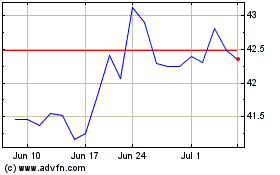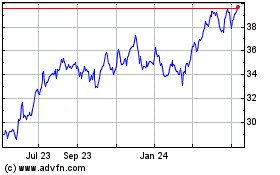By Dana Mattioli And Dana Cimilluca
The sharp decline in oil prices in the past year has put a
damper on many big energy producers' prospects, but that hasn't
kept them from joining the gusher of mergers-and-acquisitions
activity.
There have been $323 billion in announced or proposed
oil-and-gas mergers so far this year, the most on record for a
similar period by nearly $100 billion, according to Dealogic. Oil
and gas is the third-most-active sector for M&A this year and
has helped drive overall announced deal volume to $3.2 trillion
world-wide, putting 2015 on pace to roughly match the record of
$4.3 trillion set in 2007.
A handful of megamergers has been responsible for most of the
surge in energy deal volume. On Monday, Energy Transfer Equity LP
said it would buy pipeline operator Williams Cos. for roughly $32.6
billion, in the year's tenth-largest deal overall. In August,
Schlumberger Ltd., the world's largest oil-field-service company,
announced that it is buying smaller rival Cameron International
Corp. for $12.7 billion. The year's largest deal in any industry is
Royal Dutch Shell PLC's roughly $70 billion pending agreement to
buy BG Group PLC.
"The big deals that we've seen have all had strategic merit, a
consistent message from management and synergies that justify
paying a premium," said Dan Ward, co-head of Deutsche Bank AG's
global natural-resources group. "They've been done by large,
best-in-class, well-capitalized companies that can afford to be
bold," he added.
M&A activity in the oil-and-gas sector has continued apace
despite a nearly 60% decline in oil prices since early last
year.
When companies are under pressure, the value of the so-called
cost and other synergies that come from combining with rivals
increases, said Jay Horine, head of North American energy
investment banking at J.P. Morgan Chase & Co. There also is a
natural desire to get larger during such periods because bigger
companies typically outperform smaller peers when times are
tough.
"When oil prices go down like this there is always pressure to
consider mergers," Mr. Horine said. "There's a bit of a lag where
companies hope that oil will go back up, and then there are
deals."
In the third quarter, merger volume across sectors reached $1.1
trillion, with oil and gas accounting for $78 billion. That is a
19% increase in overall volume from the year-earlier period, as
companies, encouraged by strong equity markets and cheap debt,
continued to strike deals at a rapid clip.
Unlike other industries that have been active--health care is
the top M&A sector in the year to date, with more than $499
billion in announced deals, followed by technology, which has
notched $384 billion, according to Dealogic--oil-and-gas companies
have faced hostile market conditions all year.
Mirroring a trend in the overall merger market, the number of
oil-and-gas deals has been depressed as many weaker companies don't
enjoy the option of selling themselves or making acquisitions as
the course of oil prices remains unpredictable. That has created an
unbridgeable gap in many cases between buyers who are afraid of
further declines and sellers mindful of the prospect of a sharp
recovery.
Oil producer Whiting Petroleum Corp., for example, called off an
auction of the company this year when it couldn't come to an
agreement with bidders. Since then, Whiting shares have tumbled by
more than 50%, slashing its market value to $3.1 billion.
There have been just 755 deals among oil-and-gas producers so
far this year, according to Dealogic. This time last year, there
were nearly 1,200 deals despite dollar volume of $195 billion.
Companies steering clear of M&A have in many cases turned
instead to share and debt sales to shore themselves up. But such
moves may be getting harder, as drilling contractor Weatherford
International PLC found late in September when it was forced to
abandon efforts to raise about $1 billion from shares and
convertible bonds after investors balked.
The ground should become more fertile for weaker companies when
crude prices stabilize--even at the current level of about $45 a
barrel, bankers say.
"Opportunities for self-help are going to run out, so the
benefits from smart, strategic transactions will increase," said
Deutsche Bank's Mr. Ward. Strong players looking to boost
efficiency could usher in another golden era for energy M&A
like in the late 1990s, when landmark deals like combination of
Exxon and Mobil were struck, he said.
The question hanging over the deal market now is whether in the
balance of 2015 it will surge to a record, or if recent market
declines will slow it down. The market faces a number of
headwinds--mainly stemming from broader market
disruption--including a recent reversal of the tendency of
investors to buy shares of companies announcing acquisitions and
resistance of bondholders to the terms in recent auctions of debt
backing takeovers.
Access Investor Kit for "BG Group Plc"
Visit
http://www.companyspotlight.com/partner?cp_code=P479&isin=GB0008762899
Access Investor Kit for "Royal Dutch Shell PLC"
Visit
http://www.companyspotlight.com/partner?cp_code=P479&isin=GB00B03MLX29
Access Investor Kit for "Royal Dutch Shell PLC"
Visit
http://www.companyspotlight.com/partner?cp_code=P479&isin=GB00B03MM408
Access Investor Kit for "BG Group Plc"
Visit
http://www.companyspotlight.com/partner?cp_code=P479&isin=US0554342032
Access Investor Kit for "Royal Dutch Shell PLC"
Visit
http://www.companyspotlight.com/partner?cp_code=P479&isin=US7802591070
Access Investor Kit for "Royal Dutch Shell PLC"
Visit
http://www.companyspotlight.com/partner?cp_code=P479&isin=US7802592060
Subscribe to WSJ: http://online.wsj.com?mod=djnwires
(END) Dow Jones Newswires
September 30, 2015 12:19 ET (16:19 GMT)
Copyright (c) 2015 Dow Jones & Company, Inc.
Williams Companies (NYSE:WMB)
Historical Stock Chart
From Mar 2024 to Apr 2024

Williams Companies (NYSE:WMB)
Historical Stock Chart
From Apr 2023 to Apr 2024
